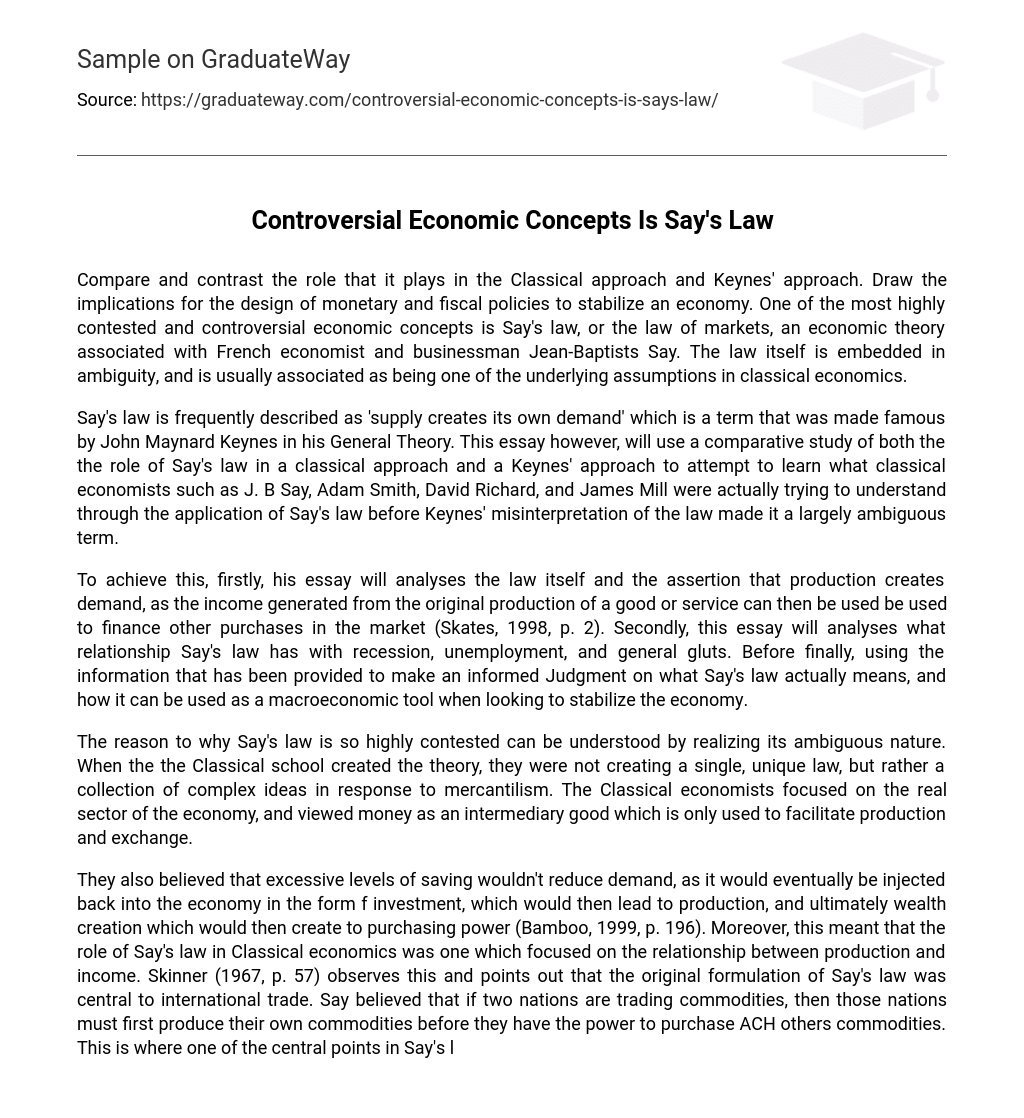The role of Say’s law in the Classical approach and Keynes’ approach is compared and contrasted, with implications drawn for the design of monetary and fiscal policies to stabilize an economy. Say’s law, or the law of markets, is a highly debated economic concept associated with French economist Jean-Baptiste Say. The law itself is unclear and typically assumed in classical economics.
Say’s law, also known as ‘supply creates its own demand’, became well-known thanks to John Maynard Keynes and his General Theory. This essay aims to compare the role of Say’s law in classical economics and Keynesian economics. By doing so, we can gain a better understanding of what economists like J.B. Say, Adam Smith, David Richard, and James Mill were trying to comprehend through the application of Say’s law before Keynes popularized a misconstrued interpretation, causing it to become a term of great ambiguity.
In order to achieve this objective, the first step is to analyze the law itself and the claim that production creates demand, as the income generated from the original production of a good or service can then be used to finance other purchases in the market (Skates, 1998, p. 2). Following this, the essay will examine the connection between Say’s law and recession, unemployment, and general gluts. Finally, utilizing the provided information, a well-informed assessment will be made regarding the true meaning of Say’s law and its potential use as a macroeconomic tool for stabilizing the economy.
The contested nature of Say’s law can be understood by acknowledging its ambiguous nature. When the Classical school devised the theory, it was not a singular law but a compilation of intricate ideas in response to mercantilism. The Classical economists concentrated on the real sector of the economy and perceived money as a medium for facilitating production and exchange.
According to Bamboo (1999, p. 196), it was believed that excessive saving would not decrease demand as it would eventually be reinvested in the economy, leading to production and wealth creation, ultimately resulting in purchasing power.
In addition, Skinner (1967, p. 57) highlights that Say’s law in Classical economics emphasized the connection between production and income. Say argued that in international trade, nations must first produce their own commodities before being able to purchase others’. Thus, a central aspect of Say’s law is that trade limitations arise not from overproduction but from underproduction in the other country, indicating a failure in supply.
The principle of Say’s law states that it can be applied to any market. It argues that the production of goods and services will generate enough income for buying other commodities. The key idea is that production should precede purchasing, making general gluts, or an excess supply over demand, impossible. Moreover, if there is a lack of demand, the economy will not experience a recession (Stilwell, 2012, p. 67).
Thomas Malthusian had a different perspective on the relationship between effective demand and economic activity compared to David Richard and James Mill. While Richard and Mill believed that there could be gluts of specific commodities but not general gluts, Malthusian argued that a general glut is possible because solely relying on the demand from those engaged in productive activities is insufficient for capital accumulation (Veggie and Greengrocer, 2003, p. 132).
John Maynard Keynes is credited with coining the phrase ‘supply creates its own demand’, which has been closely associated with Say’s law. This statement originated from Keynes’ General Theory, where he referenced the teachings of classical economists such as Say and Richard. They believed that all costs of production must be spent on purchasing the product, either directly or indirectly.
In summary, Say’s law can be understood as the belief among classical economists that production generates purchasing power and that savings are not meant to be hoarded permanently. It is not just limited to the idea that supply creates its own demand. However, Keynes used the General Theory to reinterpret Say’s law in order to challenge classical economics as a whole.





